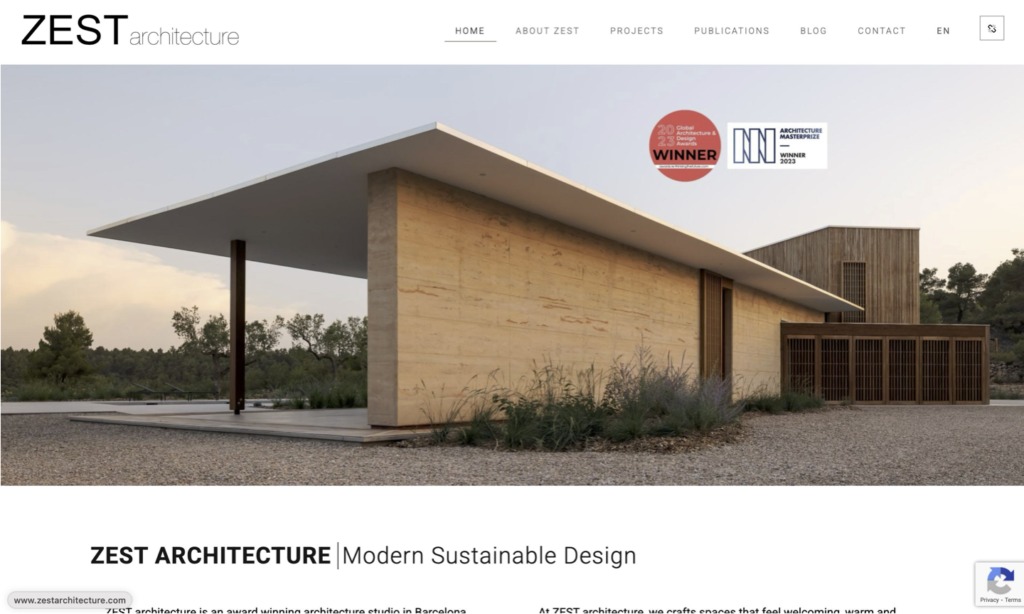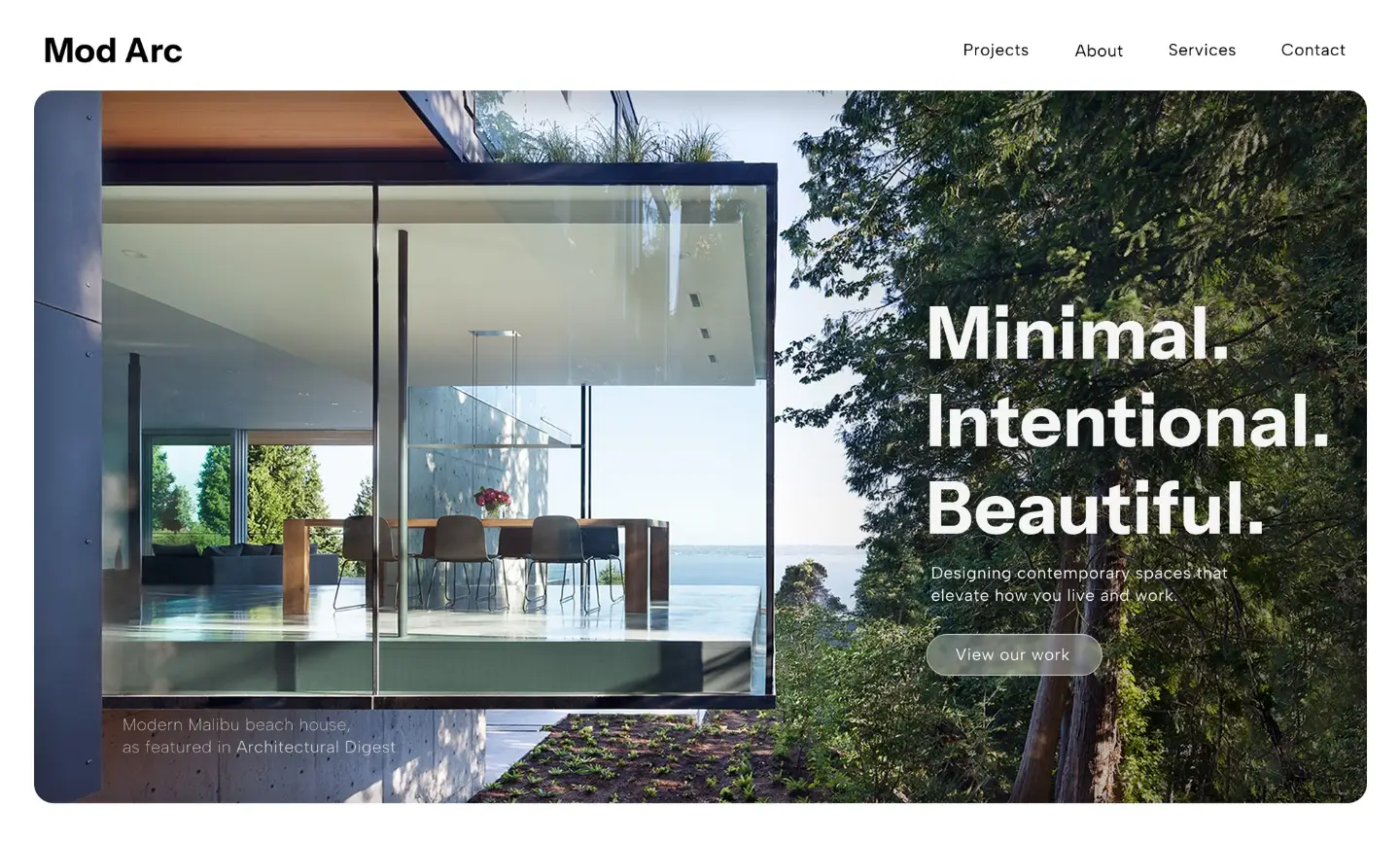
If your website isn’t converting, chances are potential clients don’t trust you enough yet.
When people are making high-stakes decisions – like hiring a firm to design their dream home, commercial space, or office – they need to feel absolutely confident in your expertise.
Social proof is how you build that confidence.
When visitors see that other clients have trusted you with major projects and were thrilled with the results, their hesitation disappears. Whether it’s showcasing past work, client testimonials, or media recognition, social proof reassures them that choosing you is the right move.
Here’s five powerful ways to use social proof on your architecture or interior design website to build trust and attract more high-value clients.
1. Showcase Client Results with Impactful Case Studies
In design-focused industries, visuals are everything—but numbers and narratives matter, too. A stunning project gallery is essential, but pairing it with compelling case studies makes your work even more persuasive.
How to Do It:
• Instead of just showing a project, tell the story behind it:
“Our redesign of [Project Name] led to a 40% increase in foot traffic for the client’s retail space.”
• Highlight before-and-after transformations with high-quality images.
• Emphasize the challenges your client faced and how your design solved them.
Example:
Challenge: A luxury home renovation client wanted to modernize their space while preserving historical elements.
Solution: We blended contemporary design with restored original features to achieve a seamless balance.
Results: Home value increased by 25%, and the project was featured in [Publication].
Potential clients want to see not just beautiful spaces but also the impact of your work—whether it’s higher property value, improved functionality, or a unique design that stands out.
2. Feature Testimonials Where They Matter Most
Many architecture and interior design firms collect client testimonials but hide them on a separate “Reviews” page. Instead, place them strategically throughout your website, especially near areas where potential clients may hesitate.
Best Places to Use Testimonials:
✔️ On project pages – Reinforce the quality of your work with client praise.
✔️ Near inquiry forms & CTAs – Reduce hesitation before they reach out.
✔️ On your About page – Build trust by showcasing past client experiences.
Best Practices for Testimonials:
• Keep them specific and results-focused. Instead of a generic “They did great work,” use:
“The redesign of our restaurant space increased bookings by 30% in the first three months.”
• Include the client’s name, title, and project details for authenticity.
• Use video testimonials for an even stronger emotional connection.
Potential clients want to hear from others who have invested in your services and were thrilled with the results. Strategic testimonials can be the final nudge they need.
3. Display Logos & Media Mentions for Instant Authority
If you’ve worked with well-known developers, luxury brands, or high-profile clients, featuring their logos on your website can immediately boost credibility. The same goes for any press mentions, awards, or features in industry publications.
Where to Feature Logos & Press Mentions:
✔️ Homepage: A simple “Trusted By” or “As Seen In” section.
✔️ Project pages: If a specific project was featured in Architectural Digest or Dwell, highlight that!
✔️ Your About page: Reinforce your experience and reputation.
✔️ Website footer: Keep your credibility visible site-wide.
Example of a Strong Logo Section:
📍 “Trusted by leading developers like [Client Logo], [Client Logo], and [Client Logo].”
📍 “As seen in [Publication], [Publication], and [Publication].”
When potential clients see that respected brands or media outlets recognize your work, they’ll be more likely to trust your expertise.
4. Leverage Numbers That Matter
While interior design and architecture are highly visual industries, statistics can still play a crucial role in establishing credibility. People trust numbers, and if you have impressive ones, showcase them prominently.
Examples of Powerful Stats to Highlight:
✅ “Over 100 high-end residential projects completed.”
✅ “20+ years of experience designing luxury spaces.”
✅ “98% client satisfaction rate with repeat business from top developers.”
Where to Display These Numbers:
✔️ Homepage: As a visually striking section.
✔️ Services page: To reinforce expertise in specific areas (e.g., “Designed over 50 boutique hotels”).
✔️ Proposal pages: To back up your pitch with credibility.
Even if you don’t have massive numbers yet, highlight engagement metrics instead. Example: “Our latest modern home project was shared over 5,000 times on social media.”
5. Use Video Walkthroughs & Case Studies
Written testimonials and images are great, but video content is even more engaging—especially in design-heavy industries. A short video walkthrough of a completed project, paired with a client testimonial, makes an emotional impact that static images alone can’t achieve.
How to Use Video for Social Proof:
• Client Video Testimonials: Have past clients share their experiences on camera. Even a simple 30-second clip builds trust.
• Behind-the-Scenes Walkthroughs: Showcase the design process to highlight your expertise.
• Before & After Comparisons: Demonstrate dramatic transformations in a dynamic way.
Example: A 60-second video featuring a client walking through their newly redesigned home, explaining how the space changed their daily life, is far more convincing than a paragraph of text.
Where to Feature Video Content:
✔️ On project pages to tell the story behind the design.
✔️ In email outreach to potential clients.
✔️ On social media to engage followers and drive traffic back to your site.
Video makes your work feel more tangible and personal, creating a deeper connection with potential clients.
Final Thoughts: Social Proof is Essential for Attracting High-Value Clients
For architecture and interior design firms, trust is everything. High-value clients need to feel confident in your ability to bring their vision to life before they commit. By strategically using social proof throughout your website, you remove doubts and make it easy for them to choose you.
Recap: 5 Best Ways to Use Social Proof on Your Website
1. Showcase Client Results with Case Studies – Go beyond pretty pictures and highlight the impact of your work.
2. Feature Testimonials Strategically – Place them where potential clients need reassurance.
3. Display Logos & Media Mentions – Let recognizable brands and press coverage boost your authority.
4. Leverage Numbers That Matter – Highlight experience, satisfaction rates, and engagement metrics.
5. Use Video Walkthroughs & Case Studies – Bring your projects to life with engaging video content.
If you’re looking to elevate your architecture or interior design firm’s online presence with a website that builds instant trust and attracts high-value clients, let’s talk.
I specialize in crafting high-end, conversion-focused websites that showcase your work at its best.
Get in touch today, and let’s create something extraordinary together.

